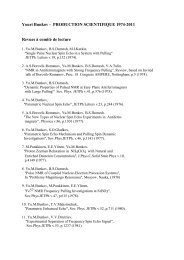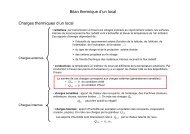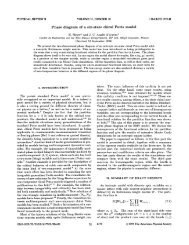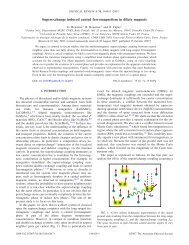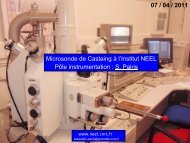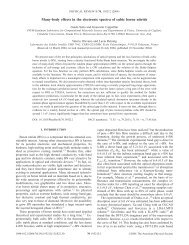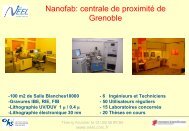Activity Report 2010 - CNRS
Activity Report 2010 - CNRS
Activity Report 2010 - CNRS
Create successful ePaper yourself
Turn your PDF publications into a flip-book with our unique Google optimized e-Paper software.
THE NÉEL IRAM KIDS<br />
ARRAYS (NIKA)<br />
The Institut Néel is coordinating the NIKA<br />
collaboration, which is developing a new<br />
instrument for the 30-m IRAM (Institut<br />
de Radio Astronomie Millimetrique)<br />
telescope at Pico Veleta, near Granada<br />
(Spain). The peculiarity of this project is<br />
the use, in the focal plane, of large arrays<br />
of the new Kinetic Inductance Detectors<br />
(KIDs).<br />
the first technical run in Pico Veleta took<br />
place already in October 2009, with very<br />
encouraging results. We could observe,<br />
for example, a number of faint galactic<br />
and extra-galactic sources. The LEKID<br />
array used at the telescope in 2009 has<br />
been fabricated at the PTA-Grenoble<br />
platform.<br />
HIGHLIGHT : NANO-CHARACTERIZATION AND METROLOGY<br />
CONTACTS<br />
monfardini@grenoble.cnrs.fr<br />
alain.benoit@grenoble.cnrs.fr<br />
FURTHER READING<br />
A. Monfardini et al., Astronomy and<br />
Astrophysics, 521, id.A29 (<strong>2010</strong>)<br />
L. Swenson et al., Applied Physics Letters,<br />
96, Issue 26, id. 263511 (<strong>2010</strong>).<br />
A. Monfardini et al., The Astrophysioal<br />
Journal, in press (2011), arXiv:1102.0870v2<br />
KIDS development<br />
The importance of millimeter and submillimeter<br />
astronomy is rapidly<br />
increasing. In particular, three main<br />
areas of millimeter continuum research<br />
have motivated the rapid development of<br />
new technologies:<br />
1. The study of the cold star-forming<br />
regions in the Galaxy<br />
2. The investigation of high-redshift<br />
galaxies, dimmed in higher energy<br />
bands<br />
3. Cosmic Microwave Background (CMB)<br />
and its anomalies (e.g. SZ effect)<br />
The Néel IRAM KIDs Arrays (NIKA)<br />
project was kicked off in November 2008.<br />
The international collaboration, led by the<br />
Institut Néel, includes Institutions in the<br />
UK (University of Cardiff), Holland<br />
(SRON), Italy (Università di Roma) and of<br />
course France (Institut Néel, IRAM-<br />
Grenoble, LPSC, LAOG). NIKA, in its final<br />
configuration, uses, in the focal plane,<br />
thousands pixels arrays of KIDs (Kinetic<br />
Inductance Detectors). A KID consist<br />
basically in a planar superconducting<br />
resonator sensitive, through changes in<br />
the film kinetic inductance, to incoming<br />
mm-wave radiation.<br />
The development of KIDs detectors in<br />
France started in 2008 in Grenoble<br />
thanks to a “Jeunes Entrants” project<br />
titled “A DC-to-THz cryogenic platform for<br />
new generations of nano-detectors”. The<br />
project was funded by the “Fondation<br />
Nanosciences” Grenoble for the period<br />
2008-2011. In particular, Dr. Loren<br />
Swenson, post-doc hired by the<br />
Foundation, boosted incredibly the<br />
project with his pre-existing competences<br />
in RF electronics.<br />
In 2009, we started investigating a<br />
particular KID concept known as LEKID<br />
(Lumped Element KID), allowing a purely<br />
planar design and a good optical<br />
coupling. Totally unexplored at that time,<br />
we realized immediately the potential of<br />
this new configuration for future large<br />
instruments operating in the mm-wave<br />
range. Thanks to the rapid development,<br />
Fig. 1: The giant IRAM telescope, located at<br />
2900m on the Sierra Nevada, south of Spain<br />
[Credits L.Swenson]. Insets: Alessandro<br />
MONFARDINI (top), Loren SWENSON (bottom<br />
left) and Christian HOFFMANN (bottom right).<br />
In <strong>2010</strong> we have further developed the<br />
first NIKA prototype to build a new, dualband<br />
instrument able to observe<br />
simultaneously at the wavelengths of<br />
2mm (150GHz) and 1.25mm (240GHz).<br />
Fig. 2: The Crab observed by NIKA in October<br />
<strong>2010</strong> from the 30-m telescope.<br />
A new observational run with the<br />
improved system, and including two KIDs<br />
arrays of respectively 144 and 256 pixels<br />
has been carried out in October <strong>2010</strong>.<br />
Thanks to the larger number of pixels,<br />
the two colors and the three-fold<br />
improvement in the detectors sensitivity,<br />
a large number of galactic and<br />
extragalactic extended sources have been<br />
detected during the six days on the sky.<br />
NIKA is today the state-of-the art<br />
concerning KIDs-based experiments, and<br />
this encourages us in proposing a multithousands<br />
pixels resident instrument,<br />
based on kinetic inductance detectors, at<br />
Pico Veleta.<br />
11



